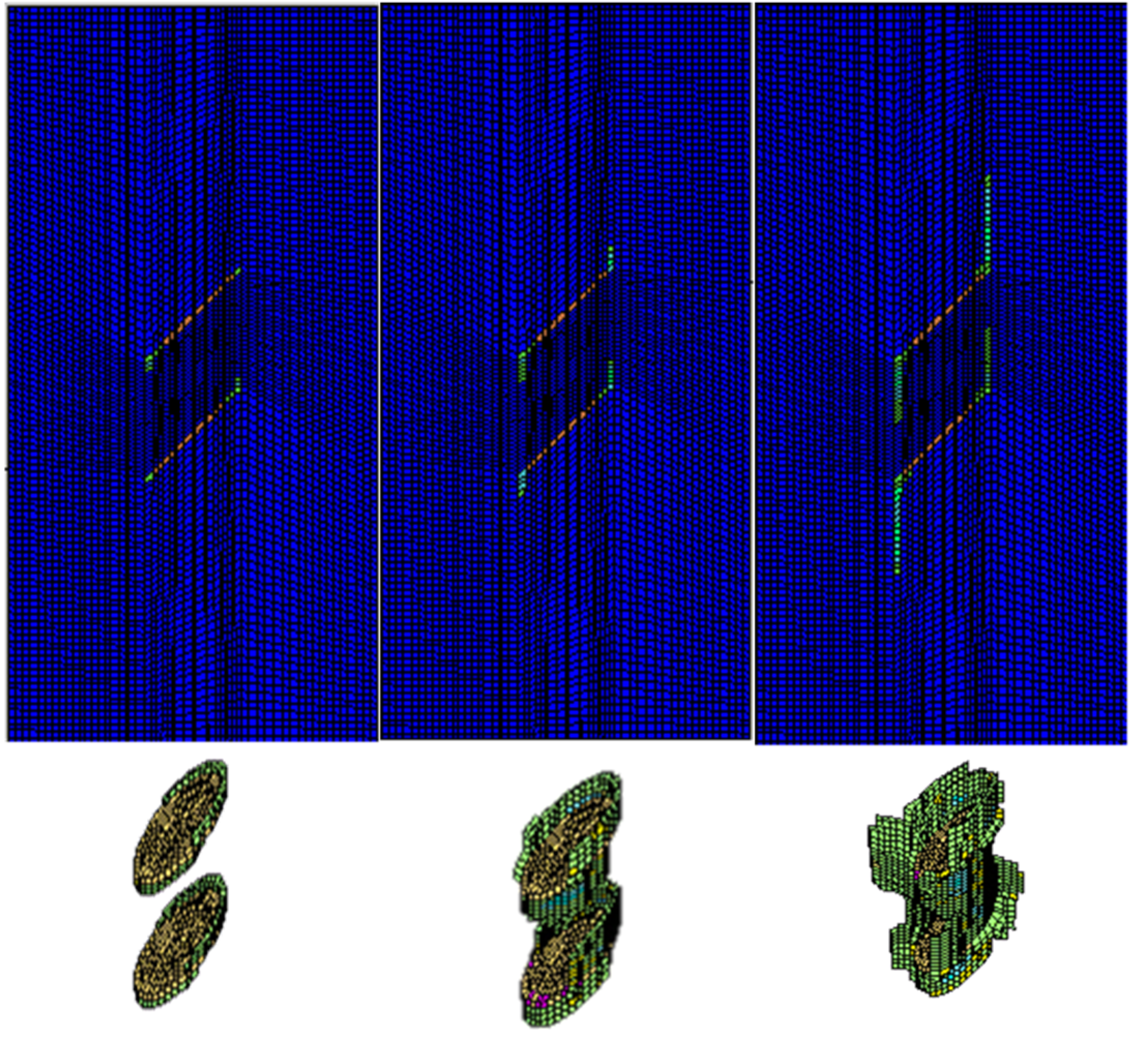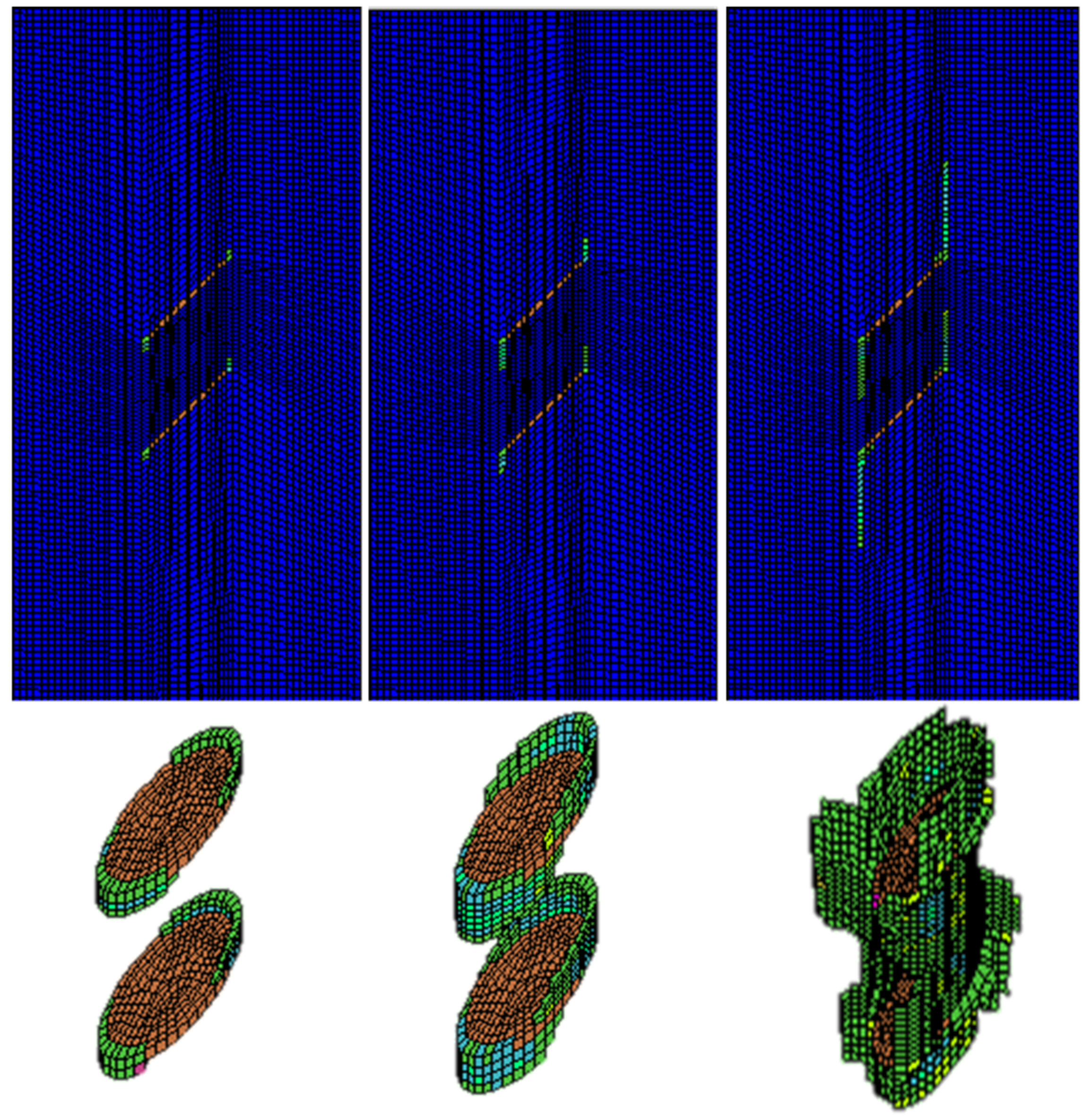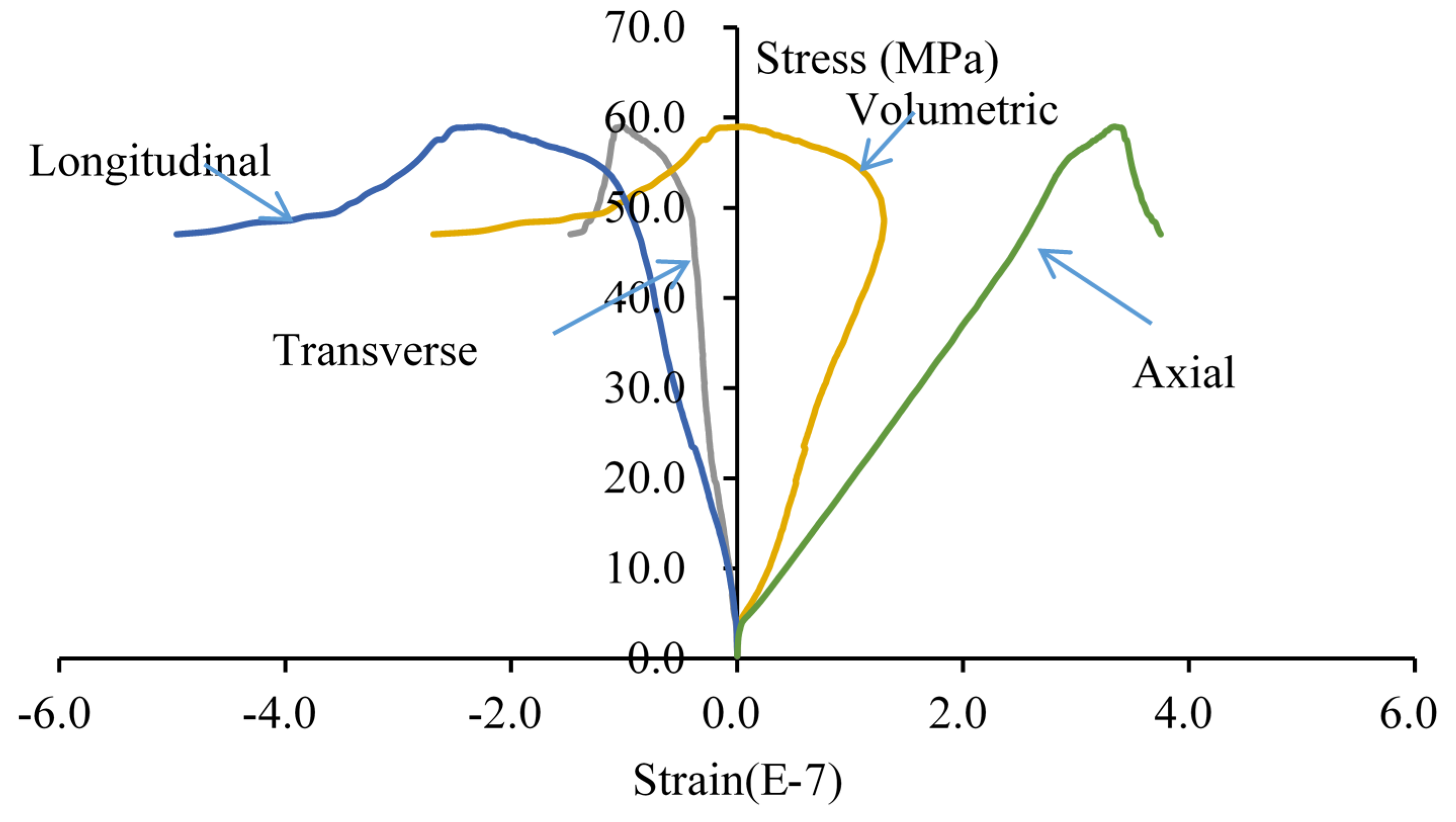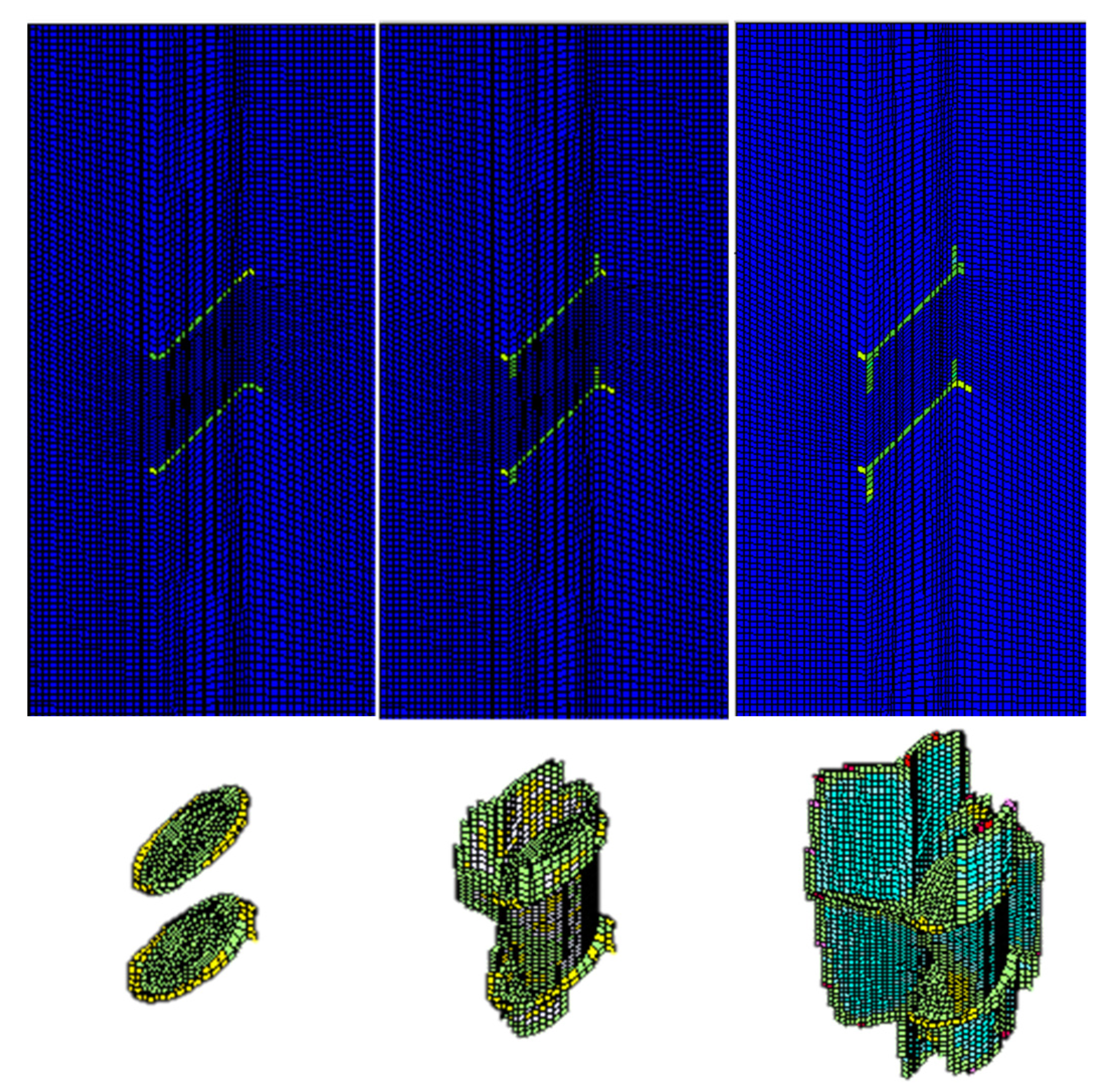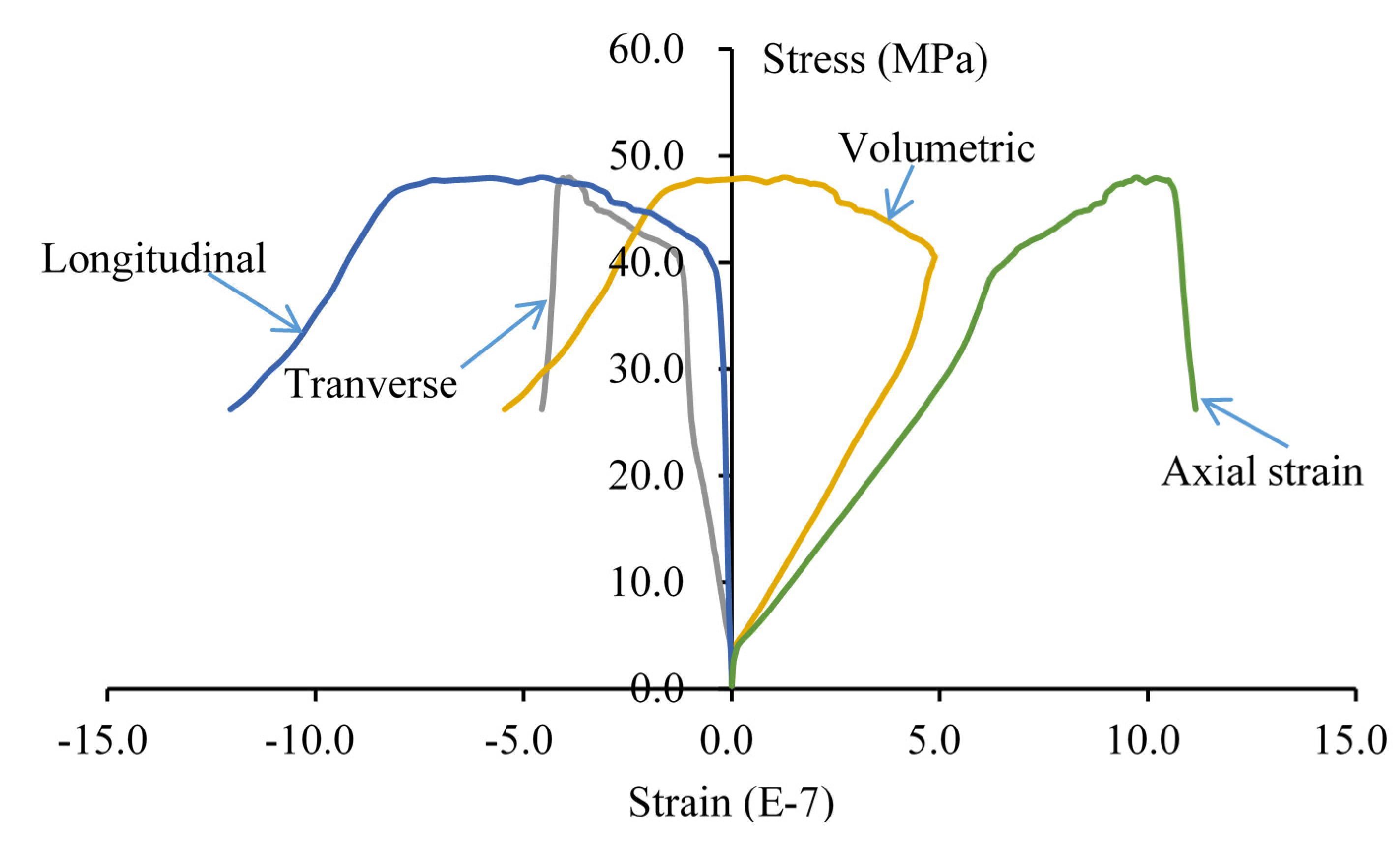Numerical Study on Crack Propagation in Brittle Jointed Rock Mass Influenced by Fracture Water Pressure
Abstract
:1. Introduction
2. An Elastic-Brittle Constitutive Model and Hydro-Mechanical Coupling
2.1. An Elastic-Brittle Constitutive Model
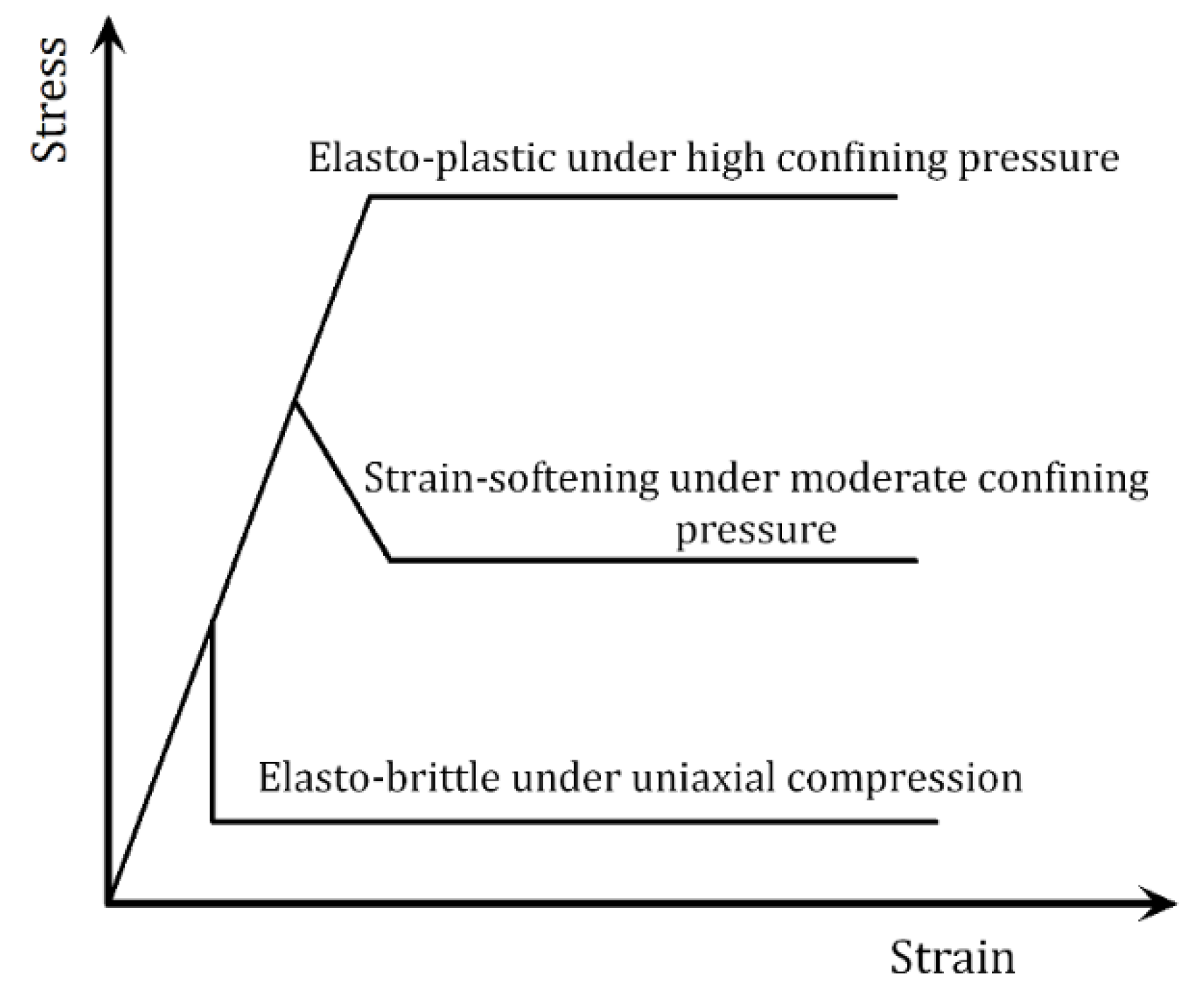
2.2. Hydro-Mechanical Coupling of Jointed Rock Mass
3. Implementation of the Elastic-Brittle Coupling Model in FLAC3D

4. Numerical Simulations on the Specimens Containing Precast Fissures
4.1. A Two-Dimensional Numerical Simulation
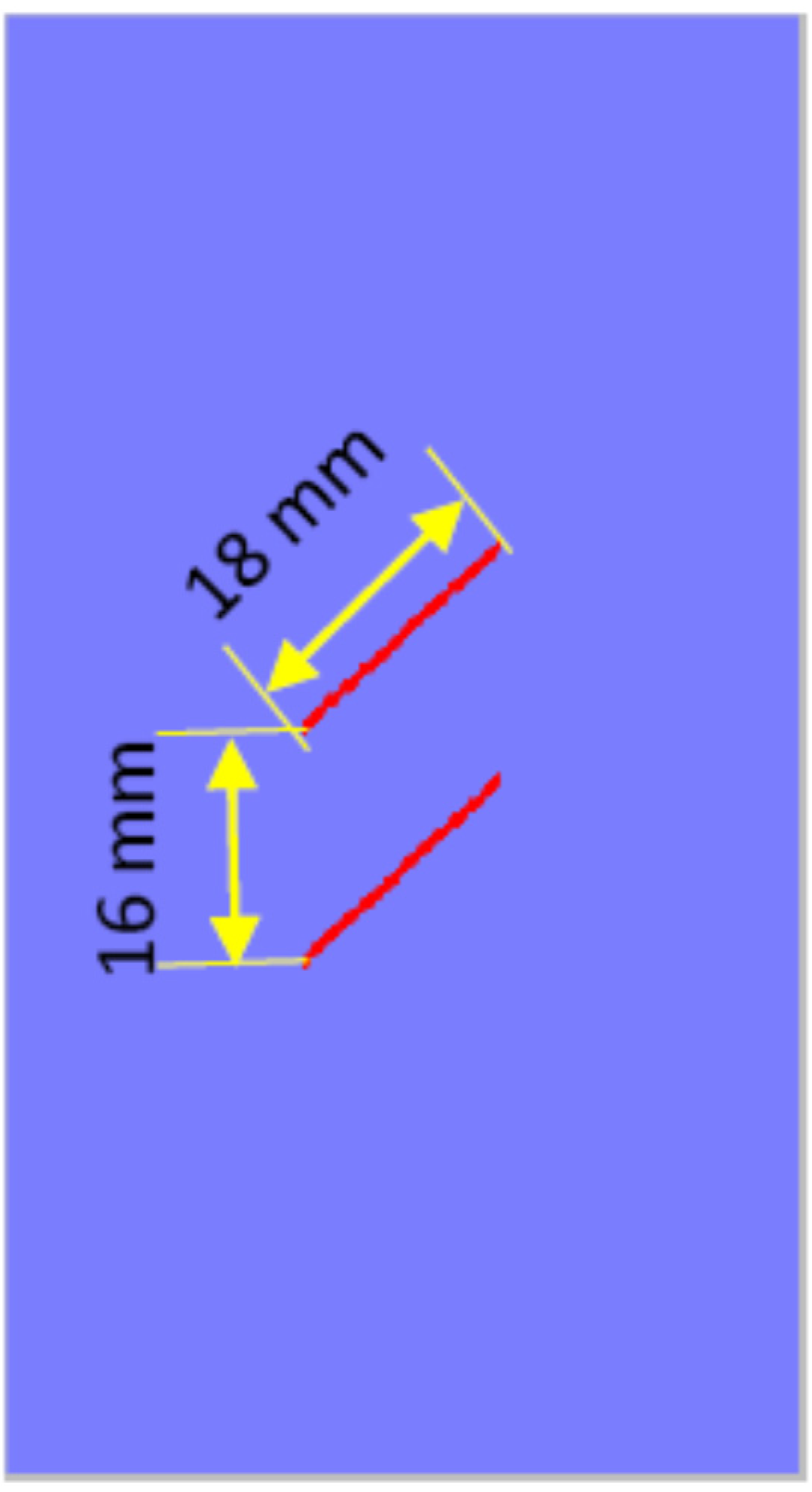
| Rock types | Elastic modulus (GPa) | Poisson’s ratio | Tensile strength (MPa) | Cohesion (MPa) | Friction angle (°) | Dilatancy angle (°) |
|---|---|---|---|---|---|---|
| Intact rock mass | 45.0 | 0.25 | 0.9 | 1.6 | 40 | 0 |
| Precast fissure | 1.5 | 0.35 | 0.5 | 0.8 | 20 | 0 |

4.2. Three-Dimensional Numerical Simulations
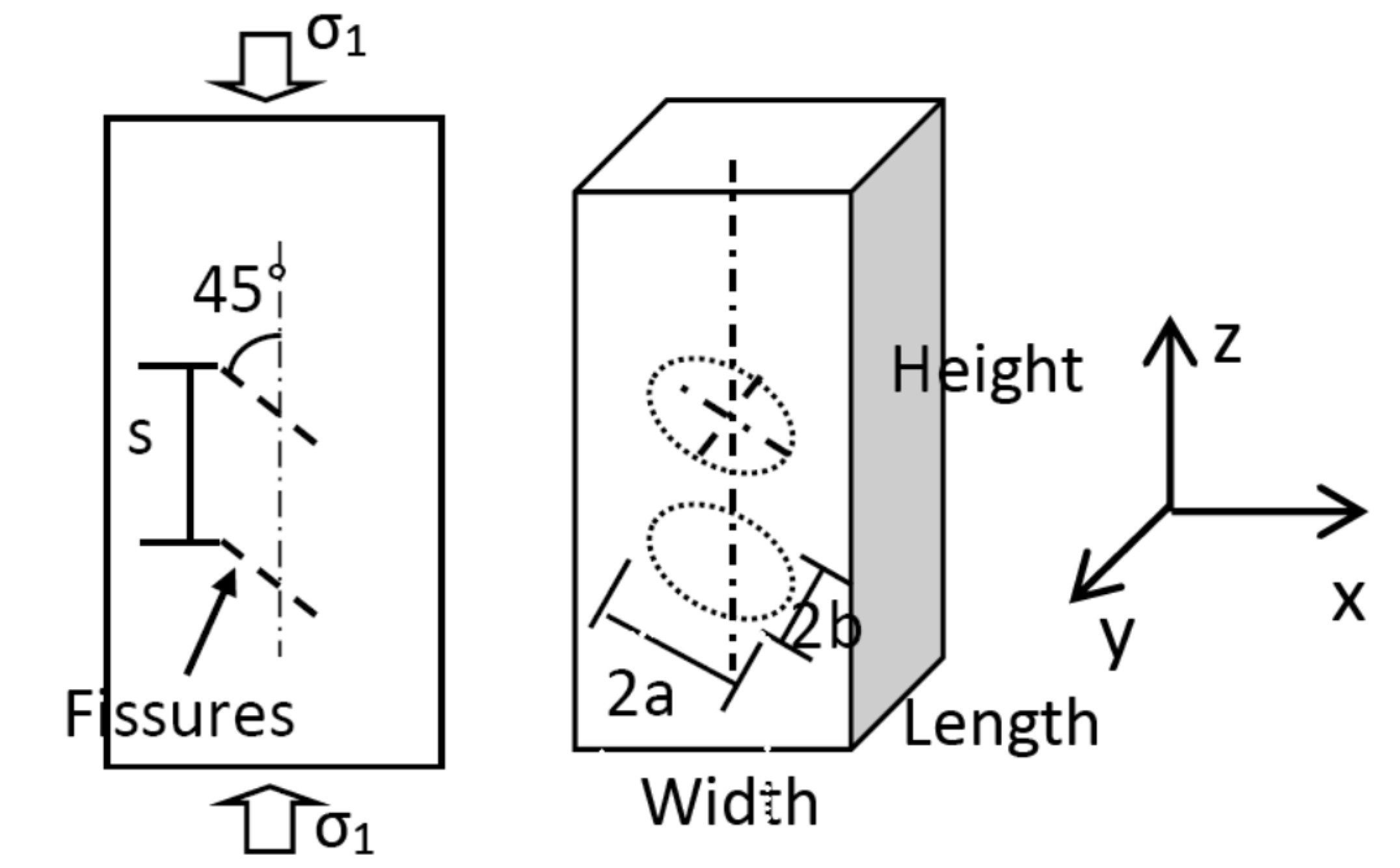
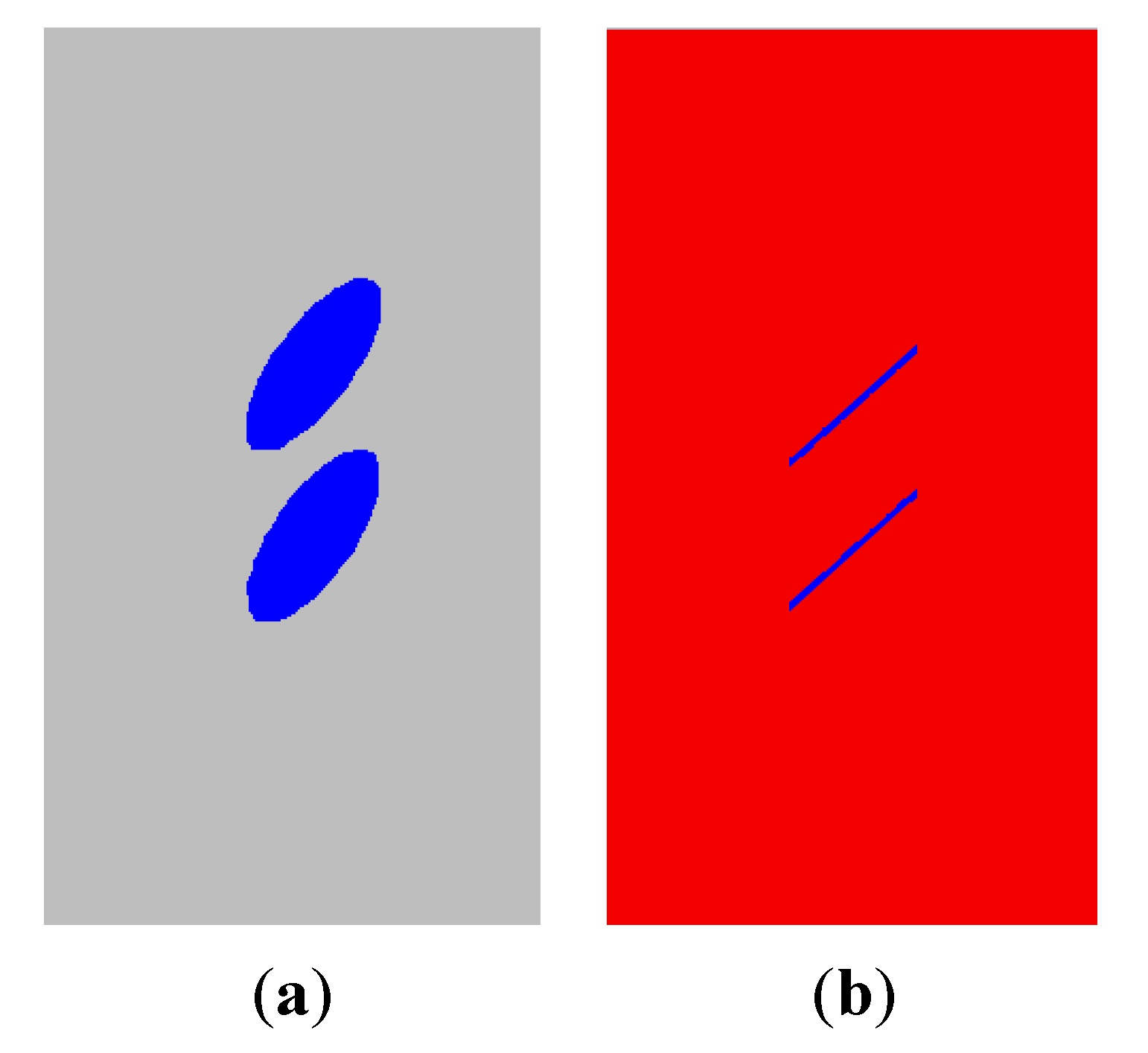
5. Conclusions
Acknowledgments
Author Contributions
Conflicts of Interest
References
- Jaeger, J.C.; Cook, N.G.W. Fundamentals of Rock Mechanics, 3rd ed.; Chapman and Hall: London, UK, 1979. [Google Scholar]
- Li, Y.; Zhu, W.S.; Fu, J.W.; Guo, Y.H.; Qi, Y.P. A damage rheology model applied to analysis of splitting failure in underground caverns of Jinping I hydropower station. Int. J. Rock Mech. Min. Sci. 2014, 71, 224–234. [Google Scholar] [CrossRef]
- Hoek, E.; Bieniawski, Z.T. Brittle fracture propagation in rock under compression. Int. J. Fract. 1965, 1, 137–155. [Google Scholar] [CrossRef]
- Bobet, A. The initiation of secondary cracks in compression. Eng. Fract. Mech. 2000, 66, 187–219. [Google Scholar] [CrossRef]
- Mughieda, O.; Alzo’ubi, A.K. Fracture mechanisms of offset rock joints—A laboratory investigation. Geotech. Geolog. Eng. 2004, 22, 545–562. [Google Scholar] [CrossRef]
- Miller, J.T.; Einstein, H.H. Crack coalescence tests on granite. In Proceedings of 42nd US Rock Mechanics Symposium, San Francisco, CA, USA, 28 June–2 July 2008. ARMA-08-162.
- Li, Y.P.; Chen, L.Z.; Wang, Y.H. Experimental research on pre-cracked marble under compression. Int. J. Solids Struct. 2005, 42, 2505–2516. [Google Scholar] [CrossRef]
- Tang, C.A.; Lin, P.; Wong, R.H.C.; Chau, K.T. Analysis of crack coalescence in rock-like materials containing three flaws-part II: Numerical approach. In. J. Rock Mech. Min. Sci. 2001, 38, 925–939. [Google Scholar] [CrossRef]
- Tang, C.A.; Kou, S.Q. Crack propagation and coalescence in brittle materials under compression. Eng. Fract. Mech. 1998, 61, 311–324. [Google Scholar] [CrossRef]
- Lee, H.; Jeon, S. An experimental and numerical study of fracture coalescence in pre-cracked specimens under uniaxial compression. Int. J. Solids Struct. 2011, 48, 979–999. [Google Scholar] [CrossRef]
- Yang, S.Q.; Huang, Y.H.; Jing, H.W.; Liu, X.R. Discrete element modeling on fracture coalescence behavior of red sandstone containing two unparallel fissures under uniaxial compression. Eng. Geol. 2014, 178, 28–48. [Google Scholar] [CrossRef]
- Manouchehrian, A.; Sharifzadeh, M.; Marji, M.F.; Gholamnejad, J. A bonded particle model for analysis of the flaw orientation effect on crack propagation mechanism in brittle materials under compression. Arch. Civ. Mech. Eng. 2014, 14, 40–52. [Google Scholar] [CrossRef]
- Mughieda, O.; Omar, M.T. Stress analysis for rock mass failure with offset joints. Geotech. Geol. Eng. 2008, 26, 543–552. [Google Scholar] [CrossRef]
- Fang, Z.; Harrison, J.P. Development of a local degradation approach to the modeling of brittle fracture in heterogeneous rocks. Int. J. Rock Mech. Min. Sci. 2002, 39, 443–457. [Google Scholar] [CrossRef]
- Fang, Z.; Harrison, J.P. Application of a local degradation model to the analysis of brittle fracture of laboratory scale rock specimens under triaxial conditions. Int. J. Rock Mech. Min. Sci. 2002, 39, 459–476. [Google Scholar] [CrossRef]
- Xie, N.; Zhu, Q.Z.; Shao, J.F.; Xu, L.H. Micromechanical analysis of damage in saturated quasi brittle materials. Int. J. Solids Struct. 2012, 49, 919–928. [Google Scholar] [CrossRef]
- Zhu, Q.Z.; Shao, J.F. A refined micromechanical damage–friction model with strength prediction for rock-like materials under compression. Int. J. Solids Struct. 2015, 60–61, 75–83. [Google Scholar] [CrossRef]
- Bikong, C.; Hoxha, D.; Shao, J.F. A micro-macro model for time-dependent behavior of clayey rocks due to anisotropic propagation of microcracks. Int. J. Plast. 2015, 69, 73–88. [Google Scholar] [CrossRef]
- Richardson, C.L.; Hegemann, J.; Sifakis, E.; Hellrung, J.; Teran, J.M. An XFEM method for modeling geometrically elaborate crack propagation in brittle materials. Int. J. Numer. Methods Eng. 2011, 88, 1042–1065. [Google Scholar] [CrossRef]
- Fast Lagrangian Analysis of Continua in 3-Dimensions, version 5.0, manual; Itasca Consulting Group Inc: Itasca, MS, USA, 2012.
- Fang, Z. A Local Degradation Approach to The Numerical Analysis of Brittle Fracture in Heterogeneous Rocks. Ph.D. Thesis, University of London, London, UK, 6 May 2001. [Google Scholar]
- Fang, Z.; Harrison, J.P. A mechanical degradation index for rock. Int. J. Rock Mech. Min. Sci. 2001, 38, 1193–1199. [Google Scholar] [CrossRef]
- Mazars, J.; Pijaudier-Cabot, G. Continuum damage theory-application to concrete. J. Eng. Mech. ASCE 1989, 115, 345–365. [Google Scholar] [CrossRef]
- Walsh, J.B. Effect of pore pressure and confining pressure on fracture permeability. Int. J. Rock Mech. Min. Sci. Geom. Abstr. 1981, 18, 429–435. [Google Scholar] [CrossRef]
- Zhao, Y.S.; Hu, Y.Q.; Zhao, B.H.; Yang, D. Coupled mathematical model for solid deformation and gas seepage of rock matrix-fractured media and its applications. J. China Coal Soc. 2003, 28, 41–45. [Google Scholar]
- Guo, Y.S.; Wong, R.H.C.; Zhu, W.S.; Chau, K.T.; Li, S.C. Study on fracture pattern of open surface-flaw in gabbro. Chin. J. Rock Mech. Eng. 2007, 26, 525–531. [Google Scholar]
© 2015 by the authors; licensee MDPI, Basel, Switzerland. This article is an open access article distributed under the terms and conditions of the Creative Commons Attribution license (http://creativecommons.org/licenses/by/4.0/).
Share and Cite
Li, Y.; Zhou, H.; Zhu, W.; Li, S.; Liu, J. Numerical Study on Crack Propagation in Brittle Jointed Rock Mass Influenced by Fracture Water Pressure. Materials 2015, 8, 3364-3376. https://doi.org/10.3390/ma8063364
Li Y, Zhou H, Zhu W, Li S, Liu J. Numerical Study on Crack Propagation in Brittle Jointed Rock Mass Influenced by Fracture Water Pressure. Materials. 2015; 8(6):3364-3376. https://doi.org/10.3390/ma8063364
Chicago/Turabian StyleLi, Yong, Hao Zhou, Weishen Zhu, Shucai Li, and Jian Liu. 2015. "Numerical Study on Crack Propagation in Brittle Jointed Rock Mass Influenced by Fracture Water Pressure" Materials 8, no. 6: 3364-3376. https://doi.org/10.3390/ma8063364






